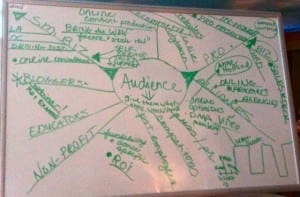 When most companies think about their website’s visitors, they think only of potential customers, but there are a host of other audiences to consider, as well.
When most companies think about their website’s visitors, they think only of potential customers, but there are a host of other audiences to consider, as well.
The web is the only medium where you can create one-to-one relationships by the thousands. That said, you really don’t know much about the people who are “meeting” you.
Identifying your audience isn’t just about pinpointing the demographics of your visitors. It is also about looking at the different categories of individuals coming to your site with varied purposes.
Most business owners just want a website with a sales message. They’re not seeing the full picture. You need to have a message for all of the different people visiting your site, whether they’re buying or not.
So, how do you figure out who’s visiting your site? …
… I use the technique of “mind mapping” with my clients, but you can use any type of brainstorming that suits you. Essentially, you want to engage in any kind of free-flowing exercise, wherein one idea can grow organically from another. It’s all about generating new and unexpected ideas.
Basically, you need to get away from a linear way of thinking and get into more of an artistic mode. It’s not about being pretty, though. Actually, mind maps are pretty messy. That’s part of the process.
- Get a small group of stakeholders in one room in front of a big, old whiteboard. (There should be more than two attendees, but probably less than 10—or it becomes impossible to write out what everyone’s saying.)
- Start talking about all of the different kinds of people who visit your website.
- Draw different circles with an individual "audience" in each one.
- Whatever comes out of it, take a photo.
- Then, separately, have attendees email the organizer with the top thing they took away from the session.
To start you out in the right direction, here’s a list of possible audiences—beyond the potential customer. It is by no means an exhaustive list but, hopefully, it will help you as you start to generate ideas.

Current Clients or Existing Shoppers
Sometimes, in the quest to garner new customers, it’s easy to forget about existing ones. You don’t want to turn a repeat customer off because your message is only for “new” people. Amazon has built their business model on this concept; they’re the master of personalization. Your method doesn’t have to be that elaborate, of course, but it should take loyal, repeat customers into consideration.
Geographically Disparate Users
Are you just speaking to people in your local area or worldwide? Do you sell to Canada or Mexico? If you are going to appeal to an audience outside of the US, you should have materials available in that group’s language.
Dealers or Distributors
If you’re in manufacturing, keep in mind that potential retailers will likely be checking you out online before doing business with you.
Alliances
Find a way to appeal to other businesses, complementary to yours. If you create a welcoming atmosphere, open to alliances, it can be a win/win.
 Competitors
Competitors
There’s nothing you can do to stop it: Competitors will come and look at your website. As such, you may want to take certain safeguards, depending on your industry. For instance, if one of your advantages is having great product photography, you may want to watermark your images.
Press or Public Relations Agents
If someone’s looking to interview an expert or report on your company, have enough information to make that person’s job as easy as possible. The media looks for ready-to-go materials. To that end, make things downloadable and be sure to have:
- An overview that includes a corporate profile and current locations.
- A backgrounder that gives the company’s history.
- Photos, charts, graphs, or illustrations that help tell your company’s story.
- Brief bios and headshots of the company’s key officers and spokespersons.
- Bulleted fact sheets about products or services.
- Testimonials or reviews.
- Links to other sites or articles that have any editorial mentions of your company.
- Recent press releases.
- A list of frequently asked questions about your company.
- Marketing collateral or brochures.
Potential Employees
As your business grows, you’ll be continuously looking for the best possible talent. Your site needs to appeal to top-tier job seekers.
Investors
Not only will individual investors check out your site, so will banks and commercial lenders. Make sure you put your best foot forward. Maintaining a thorough press area and an active area for job openings will create an air of success. (There’s a huge power to “subliminal messages” that are a result of appealing to one particular audience while addressing other audience members.)
Executives
Last (but certainly not least), you’ll need to impress your higher-ups internally. These people will inevitably be looking to see how good they look on the site. To this end, you may want to spruce up the bios and headshots!
All of these pieces of your mind map will tell a story. The message may be slightly different, depending on which audience member comes to your website, but the site as a whole should still tell a cohesive story.
So, tell me: What does your mind map look like? Did you come up with audiences you hadn’t thought about before?



